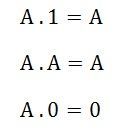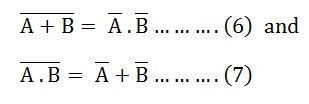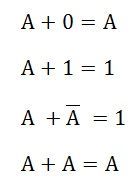Boolean theorems and laws are used to simplify the various logical expressions. In a digital designing problem, a unique logical expression is evolved from the truth table. If this logical expression is simplified the designing becomes easier. The boolean algebra is mainly used in digital electronics, set theory and digital electronics.
It is also used in all modern programming languages. Thus, Boolean theorems help in this way.
There are few basic laws and theorems of Boolean algebra, some of which are familiar to everyone such as Cumulative Law, Associative Law, Distributive law, DeMorgan’s Theorems, Double Inversion law and Duality Theorems.
The Cumulative Law
The below two equations are based on the fact that the output of an OR or AND gate remains unaffected while the inputs are exchanged themselves.
The equation of the cumulative law is given below:
The Associative Law
These laws illustrate that the order of combining input variables has no effect on the final answer.
The Distributive Law
The distributive law can be understood by the corresponding logic equivalence shown in the below. The four basic identities of OR operations are given below:
The authentication of the above all equations can be checked by substituting the value of A = 0 or A = 1.
The three basic identities of AND operations are given below:
One can check the validity of the above identities by substituting the value of A= 0 or A = 1
Double Inversion Law
The double inversion rule is shown by the equation below:![]()
The law states that the double complement (complement of the complement) of a variable equals the variable itself.
DeMorgan’s Theorems
The DeMorgan’s theorem is discussed in the article DeMorgan’s Theorem in detail.
The equations are given below:
The equation (6) says that a NOR gate is equivalent to a bubbled AND gate, and the equation (7) says that the NAND gate is equivalent to a bubbled OR gate.
Also See: DeMorgan’s Theorem
Duality Theorems
The new Boolean relation can be derived with the help of Duality theorem. According to this theorem for the given Boolean relation, the new Boolean relation can be derived by the following steps:
- Changing each OR sign to an AND sign.
- Changing each AND sign to an OR sign.
- Complementing each 0 or 1 appearing in the given Boolean identity.
For example:
The distributive law states that
Now, by using the duality theorem, we can get the new relation by interchanging each OR and AND sign. The equation (8) becomes.
The equation (9) is a new Boolean relation. Similarly, for any other Boolean relation, its dual relation can also be derived.



good and helpful
Dear sir distributive law mentioned above is wrong. it should be as under:
1) distributive property of addition with respect to multiplication
A(B+C)=AB+AC
2) distributive property of multiplication with respect to addition:
A+(B*C)=(A+B)(A+C)
Thank you so much for your explanation. I cleared all my doubts due to this!